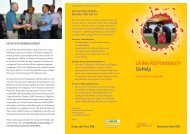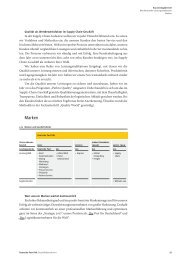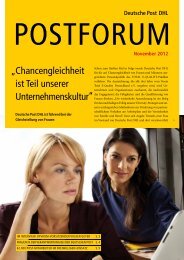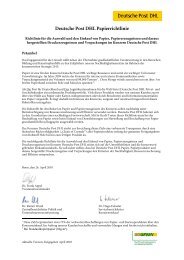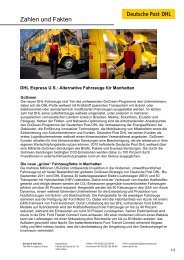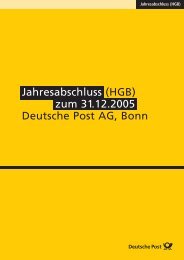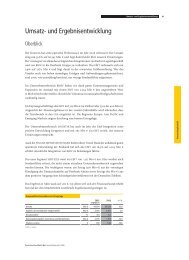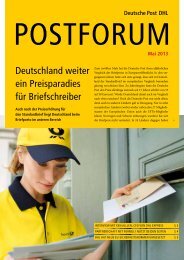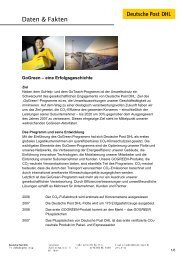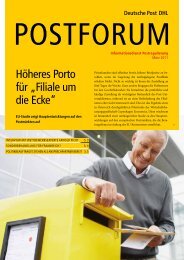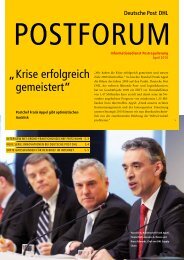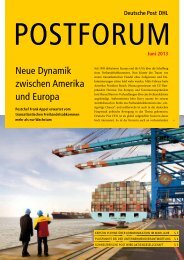You also want an ePaper? Increase the reach of your titles
YUMPU automatically turns print PDFs into web optimized ePapers that Google loves.
Creating value through rapid, systematic integration<br />
During the past two years we have pursued an expansionary acquisition policy. Driven by our strategy’s<br />
three fundamental thrusts – internationalization, broadening of our product base and expansion of our<br />
value-added logistics services – we acquired more than 20 firms.<br />
Major steps on our way to becoming a modern international<br />
logistics corporation were the acquisition of ten<br />
parcel distribution companies in Europe and our stake<br />
in <strong>DHL</strong> for the EXPRESS corporate division, the<br />
purchase of Danzas, the European Transport Division<br />
of Nedlloyd, ASG and AEI for our LOGISTICS corporate<br />
division, and <strong>Post</strong>bank and DSL Bank for our<br />
FINANCIAL SERVICES corporate division.<br />
To ensure the success of these acquisitions, we have<br />
assigned top priority to integrating them smoothly and<br />
efficiently into our Group. As a first step, we integrate<br />
newly acquired firms into the respective corporate division<br />
following a structured process.<br />
• Phase 1: Immediately establish the basic conditions<br />
necessary for success. In our opinion, the only way to<br />
ensure sufficient stability for integrating a company is<br />
to make crucial decisions without delay shortly after<br />
the acquisition is made public. For this reason, for<br />
each and every new acquisition, we set up a new organizational<br />
structure, adopt a corporate vision and<br />
objectives for the new entity, fill key positions in the<br />
new organization and set up a project team for integrating<br />
the new acquisition during the first six weeks<br />
of the integration process.<br />
• Phase 2: Develop a master plan for integration. During<br />
this phase, the tasks and issues involved in integration<br />
are prioritized on the basis of their urgency and the<br />
scope of the changes they entail. Corresponding plans<br />
are developed. The tasks involved in integrating a new<br />
acquisition can be broken down into the following<br />
general categories:<br />
- Detailed layout of the regional and functional organization;<br />
40<br />
- Systematic stipulation of individual measures to support<br />
targeted synergies;<br />
- Product standardization to enable us to offer uniform<br />
products, prices and services at international level;<br />
- Network integration which entails linking the individual<br />
companies’ transport and logistics networks with<br />
one another, coordinating routes, merging terminals<br />
and hubs;<br />
- Standardization and interlinking of IT infrastructures<br />
– the backbone of today’s modern logistics service<br />
provider;<br />
- Harmonization of reporting systems.We have adopted<br />
the International Accounting Standards for our<br />
Group;<br />
- Establishment of a uniform brand architecture. Brand<br />
awareness is very important in our business. In Germany,<br />
we stand for reliability and quality. Looking at<br />
Europe, we plan to build up a uniform brand in the<br />
express delivery field and gradually retire our new<br />
acquisitions’ local company names.We will market our<br />
logistics services worldwide under the Danzas name;<br />
- Delineation of clearly defined responsibilities with the<br />
incorporation of the acquired company’s management<br />
and culture, a move which will allow us to benefit from<br />
their experience.



